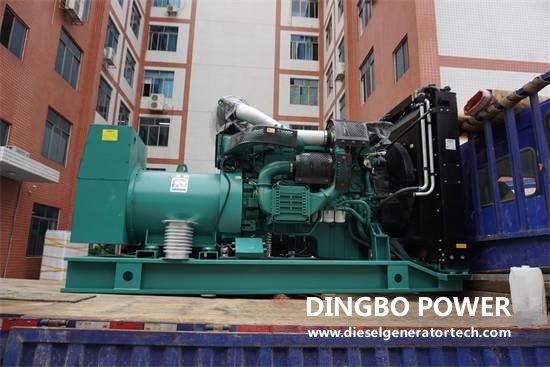Crankshaft is one of the important parts of diesel generator set. Its function is to change the reciprocating motion of the piston into rotary motion. The intake, compression and exhaust strokes of diesel generator set are completed by the shaft driving the connecting rod and the piston. The crankshaft is composed of main journal, connecting rod journal, crank arm, front end shaft, rear end flange and balance weight, etc. A connecting rod journal and the crank arms at both ends form a crank. The following Guangxi Dingbo Generator Set Manufacturing Co.,Ltd. will introduce you one by one.
(1) Crank: The distance from the centerline of the crankshaft main journal to the centerline of the connecting rod journal.
(2) Main journal: The part where the crankshaft is connected to the cylinder block. The main journal is composed of multiple tracks, which are arranged in a horizontal line. The main journal is installed in the main bearing seat, and the crankshaft is fastened on the cylinder block through the main bearing bolts, so that the crankshaft rotates in the crankcase. There are two types of main bearings: sliding bearings and rolling bearings. There are oil holes on the sliding bearing that communicate with the main pumping channel to lubricate the main journal and the main bearing.
(3) Connecting rod journal: The part connecting the crankshaft and the connecting rod. The connecting rod journal is installed in the bearing of the connecting rod big end. The connecting rod bearing mostly adopts sliding bearing. There is an oil hole on the connecting rod journal with sliding bearing, which communicates with the oil passage of the crankshaft to lubricate the connecting rod journal and the bearing. In order to reduce the inertial force when the engine is running, the connecting rod journal of some engine crankshafts is made hollow.
(4) Counterweight: A counterweight cast or forged on the crankshaft to maintain balance. Each crank has a counterweight to balance the movement. Depending on the engine, the counterweight can be a weight or another connecting rod journal. The function of the balance weight is to balance the large end of the connecting rod, the connecting rod journal, the crank arm, etc. to generate the rotating inertial force (centrifugal force) and the reciprocating inertial force generated when the piston connecting rod group performs reciprocating linear motion, so as to reduce the vibration of the internal combustion engine.

(5) Front end shaft: The front end shaft of the crankshaft is equipped with a timing gear, a fan pulley, a front oil seal, an oil retaining ring and a starting claw. Some machines that are cooled by a fan on the flywheel have a flywheel mounted on the front axle. In order to limit the axial movement of the crankshaft, the front end of the crankshaft using the sliding main bearing is also equipped with an axial positioning device called a thrust washer. There is also a method of "flanging" the main bush with soft alloy plating to achieve axial positioning. The thrust washer is poured with babbitt to reduce the friction of the thrust washer when the crankshaft moves axially. There is an axial clearance between the thrust washer and the crankshaft.
(6) Rear end flange: At the rear end of the crankshaft, there is a flange for installing the flywheel. There are screw holes and pins for fixing the flywheel on the flange. In addition, there are oil baffle rings and oil return threads to prevent oil leakage from the rear end of the crankshaft.
(7) Thrust surface: A plane machined on the crankshaft to absorb axial movement or thrust. Axial movement is the forward and backward movement along the axis of the crankshaft, which is generated by the overall movement of the crankshaft, and can also be carried by the crankshaft. Timing gears with helical teeth are produced. This type of gear is called a helical spur gear. As the engine speed increases and decreases, the load on the helical spur gear causes the crankshaft to move back and forth along its axis. This movement is absorbed by machined thrust surfaces on the crankshaft or by means of thrust bearings.
(8) Transmission flange: The crankshaft end of the drive transmission. The flywheel or flex plate is bolted to the drive flange, and the transmission is attached to the flex plate or driven by the flywheel.
(9) Fillet: The small fillet part (radius) is beneficial to increase the strength near the crankshaft fillet. The stress is easy to concentrate on the sharp corner and the drilled channel, and the fillet helps to reduce the stress.
(10) Protruding part: The shaft end of the crankshaft, used to drive accessories such as resonant balancers. Pulleys, alternators, and air conditioners.
Guangxi Dingbo Generator Set Manufacturing Co.,Ltd. is a diesel generator set manufacturer with more than 40 years of production experience. Its main brands include Yuchai generator sets, Cummins generator sets, Volvo generator sets, etc., and 64 sales and service departments nationwide. Users provide one-stop service of design, supply, debugging and maintenance. Welcome contact us by email [email protected]
Copyright © Guangxi Dingbo Generator Set Manufacturing Co., Ltd. All Rights Reserved | Sitemap
Update cookies preferences